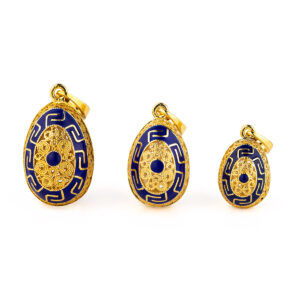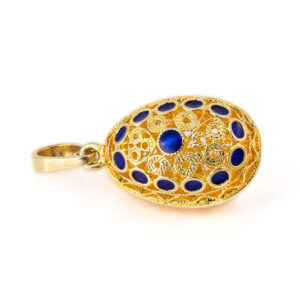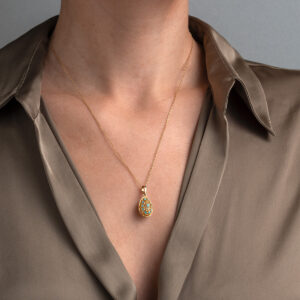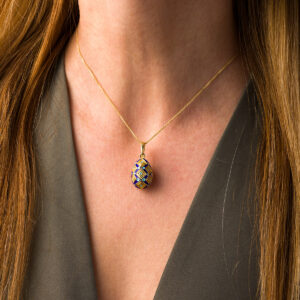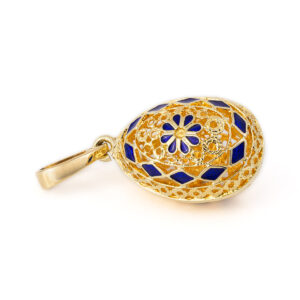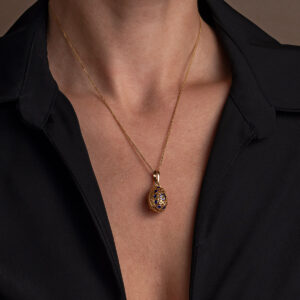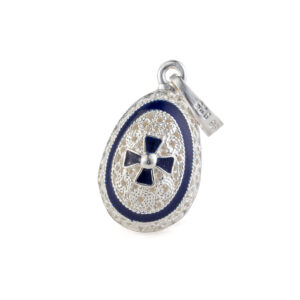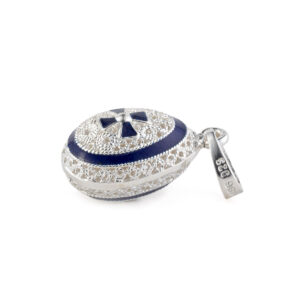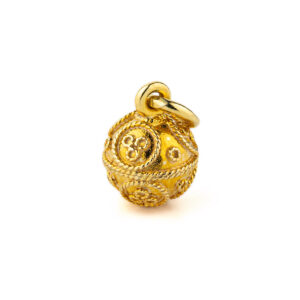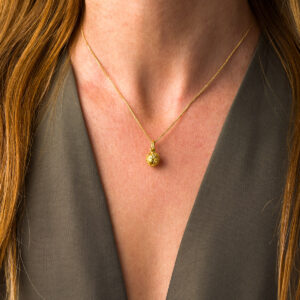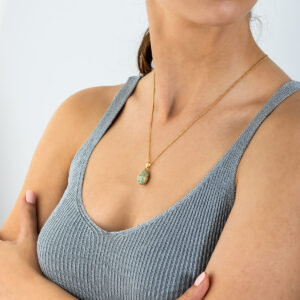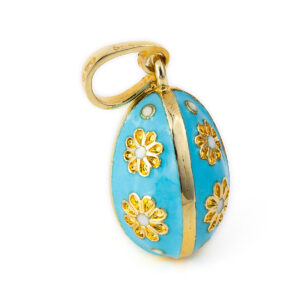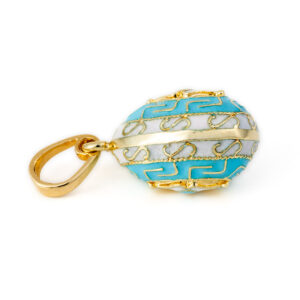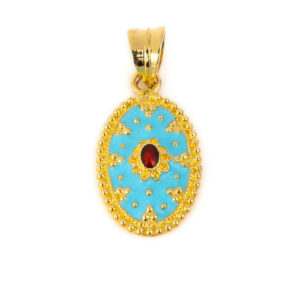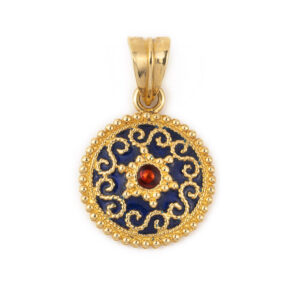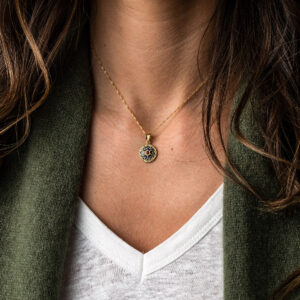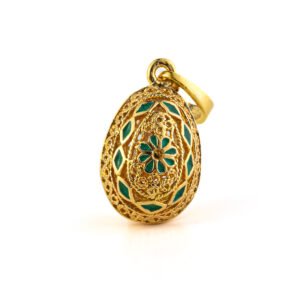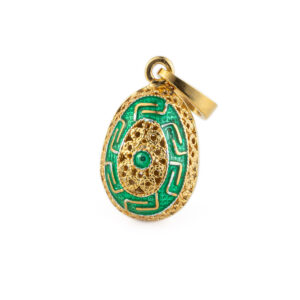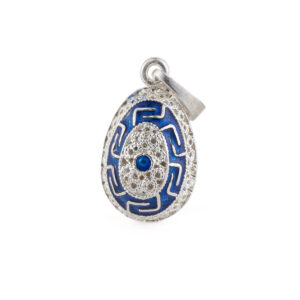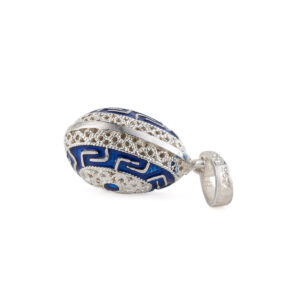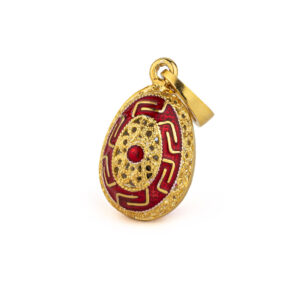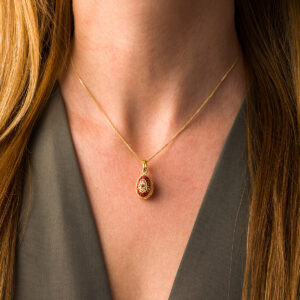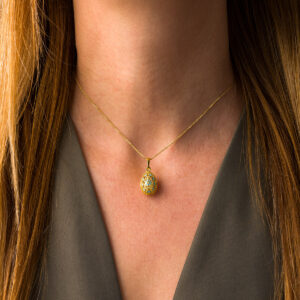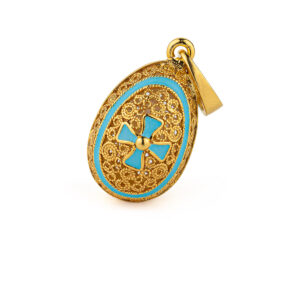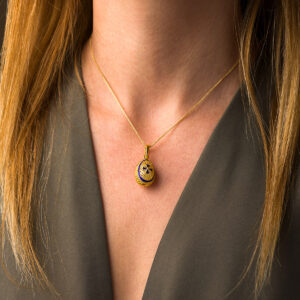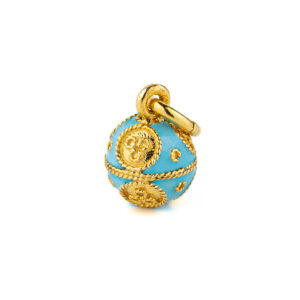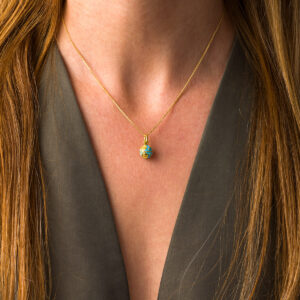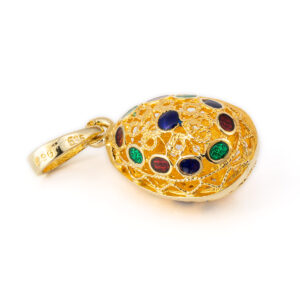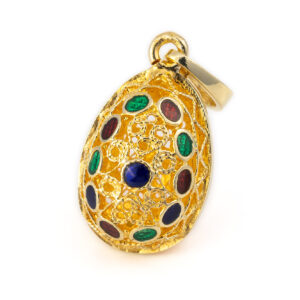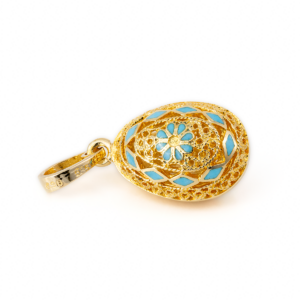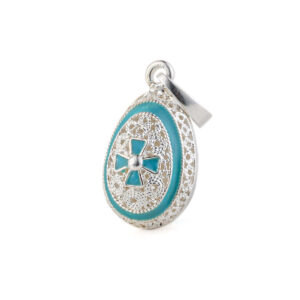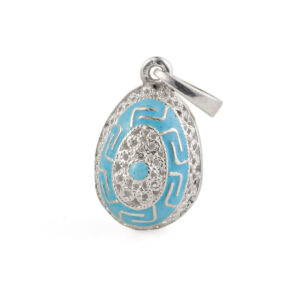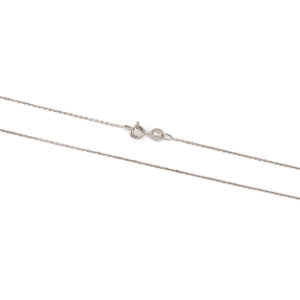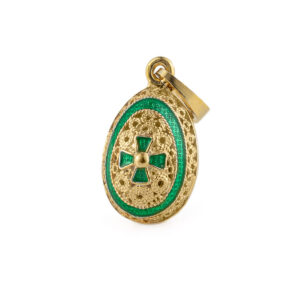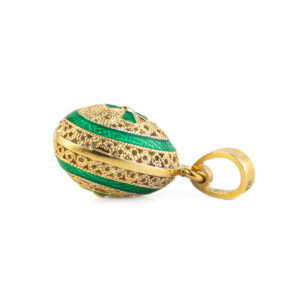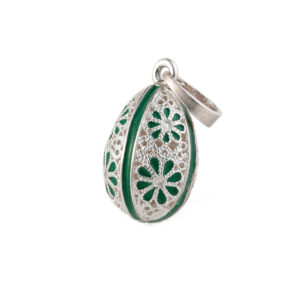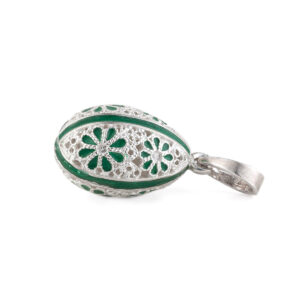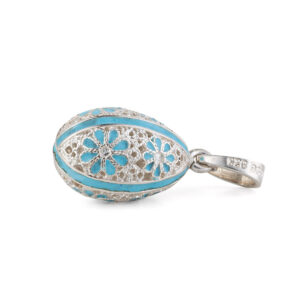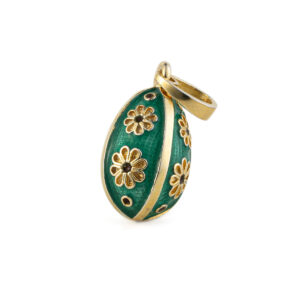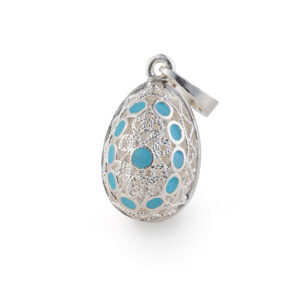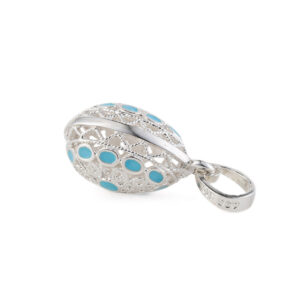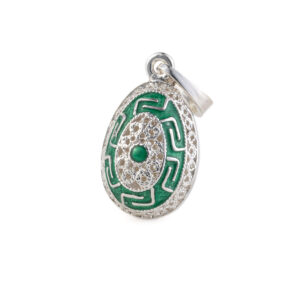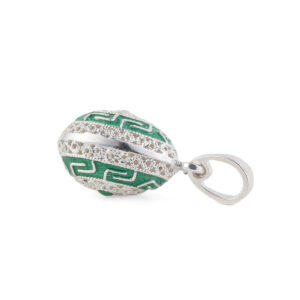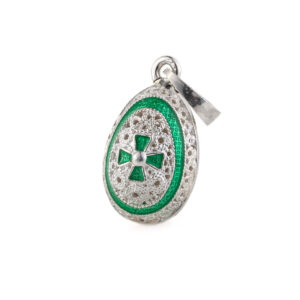The Byzantine collection includes unique handcrafted jewels which reflect the richness and glamour of the Byzantine Empire. This collection consists of earrings, rings, bracelets, necklaces, crosses in high quality 925 sterling silver and gold decorative with Byzantine motifs.
Meander Filigree Egg Pendant Necklace with Blue Enamel – Sterling Silver Gold Plated
The pendant is embellished with fine filigree and blue enamel in Faberge style. Also, the pendant is decorated with a Meander design.
Made of 925 sterling silver and gold plated.
The chain shown is included.
Filigree is a delicate kind of jewelry metalwork, made with tiny beads or twisted threads, or both in combination, soldered together or to the surface of an object of the same metal and arranged in artistic motifs. The art of filigree dates back to ancient history. The first of the found jewelry in this technique has been found in Mesopotamia and dates to thousands of years BC. In the ancient world and particularly in Asia Minor, this art grew at the highest level.
Fabergé egg is a jeweled egg created by the House of Fabergé, in St. Petersburg, Imperial Russia. Virtually all were manufactured under the supervision of Peter Carl Fabergé between 1885 and 1917,[citation needed] the most famous being the 50 “Imperial” eggs, 43 of which survive, made for the Russian Tsars Alexander III and Nicholas II as Easter gifts for their wives and mothers. The first Fabergé egg was crafted for Tsar Alexander III, who had decided to give his wife, Empress Maria Feodorovna, an Easter egg in 1885. Peter Carl Fabergé was a Russian jeweler best known for the famous Fabergé eggs made in the style of genuine Easter eggs, using precious metals and gemstones. He’s the founder of the famous jewelry legacy House of Fabergé. (Wikipedia)
Meander or Meandros design, one of the most historic symbols of the Greek World, also called Greek Key and symbolizes long life and eternity. The pattern with Meandro was used in antiquity to decorate the frieze of temples.
Filigree Egg Pendant Necklace – Sterling Silver and Gold Plated with Blue Enamel
The pendant is embellished with a fine filigree and blue enamel in Faberge style.
The chain shown is included.
Used as a charm or as a pendant.
Pick up a beautiful gift inspired by the majestic art of Fabergé!
Made of 925 sterling silver and gold plated.
The chain shown is our Cable Chain in 14K Gold (not included).
Egg pendant necklace with Square Motifs – Sterling Silver Gold Plated with Enamel
A beautifully crafted egg-shaped pendant, made of 925 sterling silver and gold plated decorated with enamel and square motifs.
Made of 925 sterling silver and gold plated.
The chain shown is included.
14k Gold and Blue Enamel Filigree Egg Pendant
645,00€The pendant is embellished with fine filigree and blue enamel in Faberge style.
Used as a charm or as a pendant.
Pick up a beautiful gift inspired by the majestic art of Fabergé!
Made in 14k yellow gold.
Handmade in Greece.
History
Filigree is a delicate kind of jewelry metalwork, made with tiny beads or twisted threads, or both in combination, soldered together or to the surface of an object of the same metal and arranged in artistic motifs. The art of filigree dates back to ancient history. The first of the found jewelry in this technique has been found in Mesopotamia and dates to thousands of years BC. In the ancient world and particularly in Asia Minor, this art grew at the highest level.
Rosette The rosette (rose) is a timeless jewel, symbol, and amulet. The origin of the term is the Greek word for rose – rodon (ρόδον). Its use began in the Mycenaean era and continues as far as the 2nd millennia BC. The Mycenaean Rosette is a motif that was widespread throughout Mesopotamia, Egypt, Greece, and other ancient civilizations. Rosette or Rodax was probably the most popular and favorite decorative element in the Mycenaean era, classical antiquity, and Byzantine times.
Fabergé egg is a jeweled egg created by the House of Fabergé, in St. Petersburg, Imperial Russia. Virtually all were manufactured under the supervision of Peter Carl Fabergé between 1885 and 1917,[citation needed] the most famous being the 50 “Imperial” eggs, 43 of which survive, made for the Russian Tsars Alexander III and Nicholas II as Easter gifts for their wives and mothers. The first Fabergé egg was crafted for Tsar Alexander III, who had decided to give his wife, the Empress Maria Feodorovna, an Easter egg in 1885. Peter Carl Fabergé was a Russian jeweller best known for the famous Fabergé eggs made in the style of genuine Easter eggs, using precious metals and gemstones. He’s the founder of the famous jewelry legacy House of Fabergé.
Cross Egg Pendant Necklace – 925 Sterling Silver and Blue Enamel
The pendant is embellished with a fine filigree and enamel in Faberge style.
Made of 925 sterling silver.
Handmade in Greece.
The chain shown is included.
Filigree is a delicate kind of jewellery metalwork, made with tiny beads or twisted threads, or both in combination, soldered together or to the surface of an object of the same metal and arranged in artistic motifs. The art of filigree dates back to ancient history. The first of the found jewelry in this technique have been found in Mesopotamia and dates to thousands of years BC. In the ancient world and particularly in Asia Minor, this art grew were at the highest level.
Fabergé egg is a jeweled egg created by the House of Fabergé, in St. Petersburg, Imperial Russia. Virtually all were manufactured under the supervision of Peter Carl Fabergé between 1885 and 1917,[citation needed] the most famous being the 50 “Imperial” eggs, 43 of which survive, made for the Russian Tsars Alexander III and Nicholas II as Easter gifts for their wives and mothers. The first Fabergé egg was crafted for Tsar Alexander III, who had decided to give his wife, the Empress Maria Feodorovna, an Easter egg in 1885. Peter Carl Fabergé was a Russian jeweller best known for the famous Fabergé eggs made in the style of genuine Easter eggs, using precious metals and gemstones. He’s the founder of the famous jewelry legacy House of Fabergé.
Egg Pendant Necklace – 925 Sterling Silver and Gold Plated
A beautifully crafted egg – shaped pendant, made of 925 sterling silver and gold plated.
Used as a charm or as a pendant.
Pick up a beautiful Easter gift!
The chain shown is included.
Filigree Egg Pendant with Flowers – 14k Gold and Turquoise Enamel
612,00€ – 952,00€The pendant is embellished with flowers in Faberge style.
Used as a charm or as a pendant.
Pick up a beautiful gift inspired by the majestic art of Fabergé!
Made in 14k gold and turquoise enamel.
The chain shown is our 14K Gold Chain (not included).
The rosette (rose) is a timeless jewel, symbol, and amulet. The origin of the term is the Greek word for rose – rodon (ρόδον). Its use began in the Mycenaean era and continues as far as the 2nd millennia BC. The Mycenaean Rosette is a motif that was widespread throughout Mesopotamia, Egypt, Greece, and other ancient civilizations. Rosette or Rodax was probably the most popular and favorite decorative element in the Mycenaean era, classical antiquity, and Byzantine times.
Fabergé egg is a jeweled egg created by the House of Fabergé, in St. Petersburg, Imperial Russia. Virtually all were manufactured under the supervision of Peter Carl Fabergé between 1885 and 1917,[citation needed] the most famous being the 50 “Imperial” eggs, 43 of which survive, made for the Russian Tsars Alexander III and Nicholas II as Easter gifts for their wives and mothers. The first Fabergé egg was crafted for Tsar Alexander III, who had decided to give his wife, Empress Maria Feodorovna, an Easter egg in 1885. Peter Carl Fabergé was a Russian jeweler best known for the famous Fabergé eggs made in the style of genuine Easter eggs, using precious metals and gemstones. He’s the founder of the famous jewelry legacy House of Fabergé.
As in all handmade items, there may be small differences in weight and dimensions, making them unique and precious.
Egg Pendant with Rosette Flowers – 14k Gold
680,00€The pendant is embellished with rosette flowers in Faberge style.
Used as a charm or as a pendant.
Pick up a beautiful gift inspired by the majestic art of Fabergé!
Made in 14k gold and turquoise enamel.
Fabergé egg is a jeweled egg created by the House of Fabergé, in St. Petersburg, Imperial Russia. Virtually all were manufactured under the supervision of Peter Carl Fabergé between 1885 and 1917,[citation needed] the most famous being the 50 “Imperial” eggs, 43 of which survive, made for the Russian Tsars Alexander III and Nicholas II as Easter gifts for their wives and mothers. The first Fabergé egg was crafted for Tsar Alexander III, who had decided to give his wife, Empress Maria Feodorovna, an Easter egg in 1885. Peter Carl Fabergé was a Russian jeweler best known for the famous Fabergé eggs made in the style of genuine Easter eggs, using precious metals and gemstones. He’s the founder of the famous jewelry legacy House of Fabergé.
The rosette (rose) is a timeless jewel, symbol, and amulet. The origin of the term is the Greek word for rose – rodon (ρόδον). Its use began in the Mycenaean era and continues as far as the 2nd millennia BC. The Mycenaean Rosette is a motif that was widespread throughout Mesopotamia, Egypt, Greece, and other ancient civilizations. Rosette or Rodax was probably the most popular and favorite decorative element in the Mycenaean era, classical antiquity, and Byzantine times.
As in all handmade items, there may be small differences in weight and dimensions, making them unique and precious.
Meander Egg Pendant with Spear Motif – 14k Gold and Enamel
645,00€The pendant is embellished with a Meander design and spear motif in Faberge style.
Used as a charm or as a pendant.
Pick up a beautiful gift inspired by the majestic art of Fabergé!
Made in 14k yellow gold and turquoise and white enamel
Fabergé egg is a jeweled egg created by the House of Fabergé, in St. Petersburg, Imperial Russia. Virtually all were manufactured under the supervision of Peter Carl Fabergé between 1885 and 1917,[citation needed] the most famous being the 50 “Imperial” eggs, 43 of which survive, made for the Russian Tsars Alexander III and Nicholas II as Easter gifts for their wives and mothers. The first Fabergé egg was crafted for Tsar Alexander III, who had decided to give his wife, Empress Maria Feodorovna, an Easter egg in 1885. Peter Carl Fabergé was a Russian jeweler best known for the famous Fabergé eggs made in the style of genuine Easter eggs, using precious metals and gemstones. He’s the founder of the famous jewelry legacy House of Fabergé.
Meander or Meandros design, one of the most historic symbols of the Greek World, also called Greek Key and symbolizes long life and eternity.
As in all handmade items, there may be small differences in weight and dimensions, making them unique and precious.
18K Gold and Turquoise Enamel Pendant
528,00€Byzantine pendant embellished with turquoise enamel and granules of precious metal.
Handmade with great attention to detail. Inspired by Byzantine art.
Made in 18k gold
Granulation (from Latin: granum = “grain”) is a jewellery technique whereby a surface of a jewel is covered with small spheres or granules of precious metal. The technique is thought to have its origins in Mesopotamia about 5,000 years ago.
18k Solid Gold Round Pendant with Blue and Red enamel
462,00€Ancient Greek Round Pendant with blue and red enamel and granules of precious metal. The back side of the pendant has no decoration.
Design inspired by the incredible beauty of historical tradition.
Made in 18k yellow gold.
The chain shown is our 14K Gold Chain in Length 40cm (not included).
Also available with turquoise enamel
Handmade item.
This technique is called Granulation. Granulation (from Latin: granum = “grain”) is a jewellery technique whereby a surface of a jewel is covered with small spheres or granules of precious metal. The technique is thought to have its origins in Mesopotamia about 5,000 years ago. As in all handmade items, there may be small differences in weight and dimensions and this is what makes them unique and precious.
Rosette Flower Egg Pendant Necklace with Enamel – 925 Sterling Silver and Gold Plated
The pendant is embellished with a fine filigree and enamel in Faberge style.
Made of 925 sterling silver and gold plated.
Handmade in Greece.
The chain shown is included.
Filigree is a delicate kind of jewellery metalwork, made with tiny beads or twisted threads, or both in combination, soldered together or to the surface of an object of the same metal and arranged in artistic motifs. The art of filigree dates back to ancient history. The first of the found jewelry in this technique have been found in Mesopotamia and dates to thousands of years BC. In the ancient world and particularly in Asia Minor, this art grew were at the highest level.
Fabergé egg is a jeweled egg created by the House of Fabergé, in St. Petersburg, Imperial Russia. Virtually all were manufactured under the supervision of Peter Carl Fabergé between 1885 and 1917,[citation needed] the most famous being the 50 “Imperial” eggs, 43 of which survive, made for the Russian Tsars Alexander III and Nicholas II as Easter gifts for their wives and mothers. The first Fabergé egg was crafted for Tsar Alexander III, who had decided to give his wife, the Empress Maria Feodorovna, an Easter egg in 1885. Peter Carl Fabergé was a Russian jeweller best known for the famous Fabergé eggs made in the style of genuine Easter eggs, using precious metals and gemstones. He’s the founder of the famous jewelry legacy House of Fabergé.
Greek Key Egg Pendant Necklace – 925 Sterling Silver and Gold Plated
The pendant is embellished with a fine filigree and enamel in Faberge style.
Made of 925 sterling silver and gold plated.
Handmade in Greece.
The chain shown is included.
Filigree is a delicate kind of jewellery metalwork, made with tiny beads or twisted threads, or both in combination, soldered together or to the surface of an object of the same metal and arranged in artistic motifs. The art of filigree dates back to ancient history. The first of the found jewelry in this technique have been found in Mesopotamia and dates to thousands of years BC. In the ancient world and particularly in Asia Minor, this art grew were at the highest level.
Fabergé egg is a jeweled egg created by the House of Fabergé, in St. Petersburg, Imperial Russia. Virtually all were manufactured under the supervision of Peter Carl Fabergé between 1885 and 1917,[citation needed] the most famous being the 50 “Imperial” eggs, 43 of which survive, made for the Russian Tsars Alexander III and Nicholas II as Easter gifts for their wives and mothers. The first Fabergé egg was crafted for Tsar Alexander III, who had decided to give his wife, the Empress Maria Feodorovna, an Easter egg in 1885. Peter Carl Fabergé was a Russian jeweller best known for the famous Fabergé eggs made in the style of genuine Easter eggs, using precious metals and gemstones. He’s the founder of the famous jewelry legacy House of Fabergé.
Greek Key Egg Enamel Pendant Necklace – 925 Sterling Silver
The pendant is embellished with a fine filigree and enamel in Faberge style.
Made of 925 sterling silver.
Handmade in Greece.
The chain shown is included.
Filigree is a delicate kind of jewellery metalwork, made with tiny beads or twisted threads, or both in combination, soldered together or to the surface of an object of the same metal and arranged in artistic motifs. The art of filigree dates back to ancient history. The first of the found jewelry in this technique have been found in Mesopotamia and dates to thousands of years BC. In the ancient world and particularly in Asia Minor, this art grew were at the highest level.
Fabergé egg is a jeweled egg created by the House of Fabergé, in St. Petersburg, Imperial Russia. Virtually all were manufactured under the supervision of Peter Carl Fabergé between 1885 and 1917,[citation needed] the most famous being the 50 “Imperial” eggs, 43 of which survive, made for the Russian Tsars Alexander III and Nicholas II as Easter gifts for their wives and mothers. The first Fabergé egg was crafted for Tsar Alexander III, who had decided to give his wife, the Empress Maria Feodorovna, an Easter egg in 1885. Peter Carl Fabergé was a Russian jeweller best known for the famous Fabergé eggs made in the style of genuine Easter eggs, using precious metals and gemstones. He’s the founder of the famous jewelry legacy House of Fabergé.
Greek Key Filigree Egg Pendant Necklace with Red Enamel – Sterling Silver Gold Plated
The pendant is embellished with a fine filigree and red enamel in Faberge style. Also the pendant decorated with Meander – Greek Key design.
The chain shown is included.
Used as a charm or as a pendant.
Pick up a beautiful Easter gift!
Made of 925 sterling silver and gold plated.
Rosette Filigree Egg Pendant Necklace – Sterling Silver Gold Plated Enamel
A beautifully crafted egg-shaped pendant with a rosette, made of 925 sterling silver and gold plated decorated with very detailed filigree motifs.
The chain shown is included.
Used as a charm or as a pendant.
Pick up a beautiful Easter gift!
Made of 925 sterling silver and gold plated.
Egg Pendant Necklace with Cross – Sterling Silver Gold Plated with Turquoise Enamel
A beautifully crafted egg-shaped pendant with a cross, made of 925 sterling silver and gold plated decorated with enamel and very detailed filigree.
Made of 925 sterling silver and gold plated.
The chain shown is included.
Filigree is a delicate kind of jewelry metalwork, made with tiny beads or twisted threads, or both in combination, soldered together or to the surface of an object of the same metal and arranged in artistic motifs. The art of filigree dates back to ancient history. The first of the found jewelry in this technique has been found in Mesopotamia and dates to thousands of years BC. In the ancient world and particularly in Asia Minor, this art grew at the highest level.
Fabergé egg is a jeweled egg created by the House of Fabergé, in St. Petersburg, Imperial Russia. Virtually all were manufactured under the supervision of Peter Carl Fabergé between 1885 and 1917,[citation needed] the most famous being the 50 “Imperial” eggs, 43 of which survive, made for the Russian Tsars Alexander III and Nicholas II as Easter gifts for their wives and mothers. The first Fabergé egg was crafted for Tsar Alexander III, who had decided to give his wife, Empress Maria Feodorovna, an Easter egg in 1885. Peter Carl Fabergé was a Russian jeweler best known for the famous Fabergé eggs made in the style of genuine Easter eggs, using precious metals and gemstones. He’s the founder of the famous jewelry legacy House of Fabergé. (Wikipedia)
Meander or Meandros design, one of the most historic symbols of the Greek World, also called Greek Key and symbolizes long life and eternity.
Egg Pendant Necklace with Cross – Sterling Silver Gold Plated and Enamel
A beautifully crafted egg-shaped pendant with a cross, made of 925 sterling silver and gold plated decorated with enamel and very detailed filigree motifs.
Made of 925 sterling silver and gold plated.
The chain shown is included.
Filigree is a delicate kind of jewelry metalwork, made with tiny beads or twisted threads, or both in combination, soldered together or to the surface of an object of the same metal and arranged in artistic motifs. The art of filigree dates back to ancient history. The first of the found jewelry in this technique has been found in Mesopotamia and dates to thousands of years BC. In the ancient world and particularly in Asia Minor, this art grew at the highest level.
Fabergé egg is a jeweled egg created by the House of Fabergé, in St. Petersburg, Imperial Russia. Virtually all were manufactured under the supervision of Peter Carl Fabergé between 1885 and 1917,[citation needed] the most famous being the 50 “Imperial” eggs, 43 of which survive, made for the Russian Tsars Alexander III and Nicholas II as Easter gifts for their wives and mothers. The first Fabergé egg was crafted for Tsar Alexander III, who had decided to give his wife, Empress Maria Feodorovna, an Easter egg in 1885. Peter Carl Fabergé was a Russian jeweler best known for the famous Fabergé eggs made in the style of genuine Easter eggs, using precious metals and gemstones. He’s the founder of the famous jewelry legacy House of Fabergé. (Wikipedia)
Meander or Meandros design, one of the most historic symbols of the Greek World, also called Greek Key and symbolizes long life and eternity. The pattern with Meandro was used in antiquity to decorate the frieze of temples.
Meander Filigree Egg Pendant Necklace with Turquoise Enamel – Sterling Silver Gold Plated
The pendant is embellished with fine filigree and turquoise enamel in Faberge style. Also, the pendant is decorated with a Meander design.
Made of 925 sterling silver and gold plated.
The chain shown is included.
Filigree is a delicate kind of jewelry metalwork, made with tiny beads or twisted threads, or both in combination, soldered together or to the surface of an object of the same metal and arranged in artistic motifs. The art of filigree dates back to ancient history. The first of the found jewelry in this technique has been found in Mesopotamia and dates to thousands of years BC. In the ancient world and particularly in Asia Minor, this art grew at the highest level.
Fabergé egg is a jeweled egg created by the House of Fabergé, in St. Petersburg, Imperial Russia. Virtually all were manufactured under the supervision of Peter Carl Fabergé between 1885 and 1917,[citation needed] the most famous being the 50 “Imperial” eggs, 43 of which survive, made for the Russian Tsars Alexander III and Nicholas II as Easter gifts for their wives and mothers. The first Fabergé egg was crafted for Tsar Alexander III, who had decided to give his wife, Empress Maria Feodorovna, an Easter egg in 1885. Peter Carl Fabergé was a Russian jeweler best known for the famous Fabergé eggs made in the style of genuine Easter eggs, using precious metals and gemstones. He’s the founder of the famous jewelry legacy House of Fabergé. (Wikipedia)
Meander or Meandros design, one of the most historic symbols of the Greek World, also called Greek Key and symbolizes long life and eternity. The pattern with Meandro was used in antiquity to decorate the frieze of temples.
Egg Pendant Necklace with Turquoise Enamel – Sterling Silver Gold Plated
A beautifully crafted egg – shaped pendant, made of 925 sterling silver and gold plated with turquoise enamel.
Used as a charm or as a pendant.
Pick up a beautiful Easter gift!
The chain shown is included.
Filigree Egg Pendant with Spiral Motifs – 14k Gold
440,00€The pendant is embellished with a fine filigree.
Used as a charm or as a pendant.
Pick up a beautiful gift inspired by the majestic art of Fabergé!
Made in 14k yellow gold and enamel dots in various colors.
Filigree is a delicate kind of jewelry metalwork, made with tiny beads or twisted threads, or both in combination, soldered together or to the surface of an object of the same metal and arranged in artistic motifs. The art of filigree dates back to ancient history. The first of the found jewelry in this technique has been found in Mesopotamia and dates to thousands of years BC. In the ancient world and particularly in Asia Minor, this art grew at the highest level.
Rosette The rosette (rose) is a timeless jewel, symbol, and amulet. The origin of the term is the Greek word for rose – rodon (ρόδον). Its use began in the Mycenaean era and continues as far as the 2nd millennia BC. The Mycenaean Rosette is a motif that was widespread throughout Mesopotamia, Egypt, Greece, and other ancient civilizations. Rosette or Rodax was probably the most popular and favorite decorative element in the Mycenaean era, classical antiquity, and Byzantine times.
Fabergé egg is a jeweled egg created by the House of Fabergé, in St. Petersburg, Imperial Russia. Virtually all were manufactured under the supervision of Peter Carl Fabergé between 1885 and 1917,[citation needed] the most famous being the 50 “Imperial” eggs, 43 of which survive, made for the Russian Tsars Alexander III and Nicholas II as Easter gifts for their wives and mothers. The first Fabergé egg was crafted for Tsar Alexander III, who had decided to give his wife, Empress Maria Feodorovna, an Easter egg in 1885. Peter Carl Fabergé was a Russian jeweler best known for the famous Fabergé eggs made in the style of genuine Easter eggs, using precious metals and gemstones. He’s the founder of the famous jewelry legacy House of Fabergé.
Filigree Egg Pendant with Rosette Flower – 14k Gold and Turquoise Enamel
510,00€The pendant is embellished with a fine filigree and turquoise enamel.
Used as a charm or as a pendant.
Pick up a beautiful gift inspired by the majestic art of Fabergé!
Made in 14k yellow gold
Filigree is a delicate kind of jewellery metalwork, made with tiny beads or twisted threads, or both in combination, soldered together or to the surface of an object of the same metal and arranged in artistic motifs. The art of filigree dates back to ancient history. The first of the found jewelry in this technique have been found in Mesopotamia and dates to thousands of years BC. In the ancient world and particularly in Asia Minor, this art grew were at the highest level.
Rosette The rosette (rose) is a timeless jewel, symbol and amulet. The origin of the term is the Greek word for rose – rodon (ρόδον). Its use began in the Mycenaean era and continues as far as the 2nd millennia BC. The Mycenaean Rosette is a motif that was widespread throughout Mesopotamia, Egypt, Greece and other ancient civilizations. Rosette or Rodax was probably the most popular and favorite decorative element in Mycenaean era, classical antiquity and Byzantine times.
Fabergé egg is a jeweled egg created by the House of Fabergé, in St. Petersburg, Imperial Russia. Virtually all were manufactured under the supervision of Peter Carl Fabergé between 1885 and 1917,[citation needed] the most famous being the 50 “Imperial” eggs, 43 of which survive, made for the Russian Tsars Alexander III and Nicholas II as Easter gifts for their wives and mothers. The first Fabergé egg was crafted for Tsar Alexander III, who had decided to give his wife, the Empress Maria Feodorovna, an Easter egg in 1885. Peter Carl Fabergé was a Russian jeweller best known for the famous Fabergé eggs made in the style of genuine Easter eggs, using precious metals and gemstones. He’s the founder of the famous jewelry legacy House of Fabergé. (wikipedia)
As in all handmade items there may be small differences in weight and dimensions and this is what makes them unique and precious.
14k Gold Meander Filigree Egg Pendant with Turquoise Enamel
510,00€ – 748,00€The pendant is embellished with a fine filigree and turquoise enamel in Faberge style. Also, the pendant is decorated with a Meander design.
Used as a charm or as a pendant.
Pick up a beautiful gift inspired by the majestic art of Fabergé!
Made in 14k yellow gold
Filigree is a delicate kind of jewellery metalwork, made with tiny beads or twisted threads, or both in combination, soldered together or to the surface of an object of the same metal and arranged in artistic motifs. The art of filigree dates back to ancient history. The first of the found jewelry in this technique has been found in Mesopotamia and dates to thousands of years BC. In the ancient world, particularly in Asia Minor, this art grew at the highest level.
Fabergé egg is a jeweled egg created by the House of Fabergé, in St. Petersburg, Imperial Russia. Virtually all were manufactured under the supervision of Peter Carl Fabergé between 1885 and 1917,[citation needed] the most famous being the 50 “Imperial” eggs, 43 of which survive, made for the Russian Tsars Alexander III and Nicholas II as Easter gifts for their wives and mothers. The first Fabergé egg was crafted for Tsar Alexander III, who had decided to give his wife, Empress Maria Feodorovna, an Easter egg in 1885. Peter Carl Fabergé was a Russian jeweller best known for the famous Fabergé eggs made in the style of genuine Easter eggs, using precious metals and gemstones. He’s the founder of the famous jewelry legacy House of Fabergé. (Wikipedia)
Meander or Meandros design, one of the most historic symbols of the Greek World, also called Greek Key and symbolizes long life and eternity.
Cross Egg Pendant Necklace – 925 Sterling Silver and Turquoise Enamel
The pendant is embellished with a fine filigree and enamel in Faberge style.
Made of 925 sterling silver.
Handmade in Greece.
The chain shown is included.
Filigree is a delicate kind of jewellery metalwork, made with tiny beads or twisted threads, or both in combination, soldered together or to the surface of an object of the same metal and arranged in artistic motifs. The art of filigree dates back to ancient history. The first of the found jewelry in this technique have been found in Mesopotamia and dates to thousands of years BC. In the ancient world and particularly in Asia Minor, this art grew were at the highest level.
Fabergé egg is a jeweled egg created by the House of Fabergé, in St. Petersburg, Imperial Russia. Virtually all were manufactured under the supervision of Peter Carl Fabergé between 1885 and 1917,[citation needed] the most famous being the 50 “Imperial” eggs, 43 of which survive, made for the Russian Tsars Alexander III and Nicholas II as Easter gifts for their wives and mothers. The first Fabergé egg was crafted for Tsar Alexander III, who had decided to give his wife, the Empress Maria Feodorovna, an Easter egg in 1885. Peter Carl Fabergé was a Russian jeweller best known for the famous Fabergé eggs made in the style of genuine Easter eggs, using precious metals and gemstones. He’s the founder of the famous jewelry legacy House of Fabergé.
Greek Key Egg Pendant Necklace with Enamel – 925 Sterling Silver
The pendant is embellished with a fine filigree and enamel in Faberge style.
Made of 925 sterling silver.
Handmade in Greece.
The chain shown is included.
Filigree is a delicate kind of jewellery metalwork, made with tiny beads or twisted threads, or both in combination, soldered together or to the surface of an object of the same metal and arranged in artistic motifs. The art of filigree dates back to ancient history. The first of the found jewelry in this technique have been found in Mesopotamia and dates to thousands of years BC. In the ancient world and particularly in Asia Minor, this art grew were at the highest level.
Fabergé egg is a jeweled egg created by the House of Fabergé, in St. Petersburg, Imperial Russia. Virtually all were manufactured under the supervision of Peter Carl Fabergé between 1885 and 1917,[citation needed] the most famous being the 50 “Imperial” eggs, 43 of which survive, made for the Russian Tsars Alexander III and Nicholas II as Easter gifts for their wives and mothers. The first Fabergé egg was crafted for Tsar Alexander III, who had decided to give his wife, the Empress Maria Feodorovna, an Easter egg in 1885. Peter Carl Fabergé was a Russian jeweller best known for the famous Fabergé eggs made in the style of genuine Easter eggs, using precious metals and gemstones. He’s the founder of the famous jewelry legacy House of Fabergé.
Cross Egg Pendant Necklace with Enamel– 925 Sterling Silver and Gold Plated
The pendant is embellished with a fine filigree and enamel in Faberge style.
Made of 925 sterling silver and gold plated.
Handmade in Greece.
The chain shown is included.
Filigree is a delicate kind of jewellery metalwork, made with tiny beads or twisted threads, or both in combination, soldered together or to the surface of an object of the same metal and arranged in artistic motifs. The art of filigree dates back to ancient history. The first of the found jewelry in this technique have been found in Mesopotamia and dates to thousands of years BC. In the ancient world and particularly in Asia Minor, this art grew were at the highest level.
Fabergé egg is a jeweled egg created by the House of Fabergé, in St. Petersburg, Imperial Russia. Virtually all were manufactured under the supervision of Peter Carl Fabergé between 1885 and 1917,[citation needed] the most famous being the 50 “Imperial” eggs, 43 of which survive, made for the Russian Tsars Alexander III and Nicholas II as Easter gifts for their wives and mothers. The first Fabergé egg was crafted for Tsar Alexander III, who had decided to give his wife, the Empress Maria Feodorovna, an Easter egg in 1885. Peter Carl Fabergé was a Russian jeweller best known for the famous Fabergé eggs made in the style of genuine Easter eggs, using precious metals and gemstones. He’s the founder of the famous jewelry legacy House of Fabergé.
Flowers Egg Pendant Necklace with Green Enamel – 925 Sterling Silver
The pendant is embellished with a fine filigree and enamel in Faberge style.
Made of 925 sterling silver.
Handmade in Greece.
The chain shown is included.
Filigree is a delicate kind of jewellery metalwork, made with tiny beads or twisted threads, or both in combination, soldered together or to the surface of an object of the same metal and arranged in artistic motifs. The art of filigree dates back to ancient history. The first of the found jewelry in this technique have been found in Mesopotamia and dates to thousands of years BC. In the ancient world and particularly in Asia Minor, this art grew were at the highest level.
Fabergé egg is a jeweled egg created by the House of Fabergé, in St. Petersburg, Imperial Russia. Virtually all were manufactured under the supervision of Peter Carl Fabergé between 1885 and 1917,[citation needed] the most famous being the 50 “Imperial” eggs, 43 of which survive, made for the Russian Tsars Alexander III and Nicholas II as Easter gifts for their wives and mothers. The first Fabergé egg was crafted for Tsar Alexander III, who had decided to give his wife, the Empress Maria Feodorovna, an Easter egg in 1885. Peter Carl Fabergé was a Russian jeweller best known for the famous Fabergé eggs made in the style of genuine Easter eggs, using precious metals and gemstones. He’s the founder of the famous jewelry legacy House of Fabergé.
Flowers Egg Pendant Necklace – 925 Sterling Silver
The pendant is embellished with a fine filigree and enamel in Faberge style.
Made of 925 sterling silver.
Handmade in Greece.
The chain shown is included.
Filigree is a delicate kind of jewellery metalwork, made with tiny beads or twisted threads, or both in combination, soldered together or to the surface of an object of the same metal and arranged in artistic motifs. The art of filigree dates back to ancient history. The first of the found jewelry in this technique have been found in Mesopotamia and dates to thousands of years BC. In the ancient world and particularly in Asia Minor, this art grew were at the highest level.
Fabergé egg is a jeweled egg created by the House of Fabergé, in St. Petersburg, Imperial Russia. Virtually all were manufactured under the supervision of Peter Carl Fabergé between 1885 and 1917,[citation needed] the most famous being the 50 “Imperial” eggs, 43 of which survive, made for the Russian Tsars Alexander III and Nicholas II as Easter gifts for their wives and mothers. The first Fabergé egg was crafted for Tsar Alexander III, who had decided to give his wife, the Empress Maria Feodorovna, an Easter egg in 1885. Peter Carl Fabergé was a Russian jeweller best known for the famous Fabergé eggs made in the style of genuine Easter eggs, using precious metals and gemstones. He’s the founder of the famous jewelry legacy House of Fabergé.
Flower Egg Pendant Necklace – 925 Sterling Silver and Green Enamel
The pendant is embellished with a fine filigree and enamel in Faberge style.
Made of 925 sterling silver and gold plated.
Handmade in Greece.
The chain shown is included.
Filigree is a delicate kind of jewellery metalwork, made with tiny beads or twisted threads, or both in combination, soldered together or to the surface of an object of the same metal and arranged in artistic motifs. The art of filigree dates back to ancient history. The first of the found jewelry in this technique have been found in Mesopotamia and dates to thousands of years BC. In the ancient world and particularly in Asia Minor, this art grew were at the highest level.
Fabergé egg is a jeweled egg created by the House of Fabergé, in St. Petersburg, Imperial Russia. Virtually all were manufactured under the supervision of Peter Carl Fabergé between 1885 and 1917,[citation needed] the most famous being the 50 “Imperial” eggs, 43 of which survive, made for the Russian Tsars Alexander III and Nicholas II as Easter gifts for their wives and mothers. The first Fabergé egg was crafted for Tsar Alexander III, who had decided to give his wife, the Empress Maria Feodorovna, an Easter egg in 1885. Peter Carl Fabergé was a Russian jeweller best known for the famous Fabergé eggs made in the style of genuine Easter eggs, using precious metals and gemstones. He’s the founder of the famous jewelry legacy House of Fabergé.
Filigree Egg Pendant Necklace with Spiral Motifs – 925 Sterling Silver and Turquoise Enamel
The pendant is embellished with a fine filigree and enamel in Faberge style.
Made of 925 sterling silver.
Handmade in Greece.
The chain shown is included.
Filigree is a delicate kind of jewellery metalwork, made with tiny beads or twisted threads, or both in combination, soldered together or to the surface of an object of the same metal and arranged in artistic motifs. The art of filigree dates back to ancient history. The first of the found jewelry in this technique have been found in Mesopotamia and dates to thousands of years BC. In the ancient world and particularly in Asia Minor, this art grew were at the highest level.
Fabergé egg is a jeweled egg created by the House of Fabergé, in St. Petersburg, Imperial Russia. Virtually all were manufactured under the supervision of Peter Carl Fabergé between 1885 and 1917,[citation needed] the most famous being the 50 “Imperial” eggs, 43 of which survive, made for the Russian Tsars Alexander III and Nicholas II as Easter gifts for their wives and mothers. The first Fabergé egg was crafted for Tsar Alexander III, who had decided to give his wife, the Empress Maria Feodorovna, an Easter egg in 1885. Peter Carl Fabergé was a Russian jeweller best known for the famous Fabergé eggs made in the style of genuine Easter eggs, using precious metals and gemstones. He’s the founder of the famous jewelry legacy House of Fabergé.
Greek Key Egg Pendant Necklace – 925 Sterling Silver and Green Enamel
The pendant is embellished with a fine filigree and enamel in Faberge style.
Made of 925 sterling silver.
Handmade in Greece.
The chain shown is included.
Filigree is a delicate kind of jewellery metalwork, made with tiny beads or twisted threads, or both in combination, soldered together or to the surface of an object of the same metal and arranged in artistic motifs. The art of filigree dates back to ancient history. The first of the found jewelry in this technique have been found in Mesopotamia and dates to thousands of years BC. In the ancient world and particularly in Asia Minor, this art grew were at the highest level.
Fabergé egg is a jeweled egg created by the House of Fabergé, in St. Petersburg, Imperial Russia. Virtually all were manufactured under the supervision of Peter Carl Fabergé between 1885 and 1917,[citation needed] the most famous being the 50 “Imperial” eggs, 43 of which survive, made for the Russian Tsars Alexander III and Nicholas II as Easter gifts for their wives and mothers. The first Fabergé egg was crafted for Tsar Alexander III, who had decided to give his wife, the Empress Maria Feodorovna, an Easter egg in 1885. Peter Carl Fabergé was a Russian jeweller best known for the famous Fabergé eggs made in the style of genuine Easter eggs, using precious metals and gemstones. He’s the founder of the famous jewelry legacy House of Fabergé.
Cross Egg Pendant Necklace – 925 Sterling Silver and Green Enamel
The pendant is embellished with a fine filigree and enamel in Faberge style.
Made of 925 sterling silver.
Handmade in Greece.
The chain shown is included.
Filigree is a delicate kind of jewellery metalwork, made with tiny beads or twisted threads, or both in combination, soldered together or to the surface of an object of the same metal and arranged in artistic motifs. The art of filigree dates back to ancient history. The first of the found jewelry in this technique have been found in Mesopotamia and dates to thousands of years BC. In the ancient world and particularly in Asia Minor, this art grew were at the highest level.
Fabergé egg is a jeweled egg created by the House of Fabergé, in St. Petersburg, Imperial Russia. Virtually all were manufactured under the supervision of Peter Carl Fabergé between 1885 and 1917,[citation needed] the most famous being the 50 “Imperial” eggs, 43 of which survive, made for the Russian Tsars Alexander III and Nicholas II as Easter gifts for their wives and mothers. The first Fabergé egg was crafted for Tsar Alexander III, who had decided to give his wife, the Empress Maria Feodorovna, an Easter egg in 1885. Peter Carl Fabergé was a Russian jeweller best known for the famous Fabergé eggs made in the style of genuine Easter eggs, using precious metals and gemstones. He’s the founder of the famous jewelry legacy House of Fabergé.

